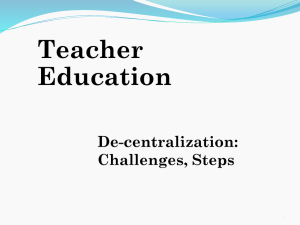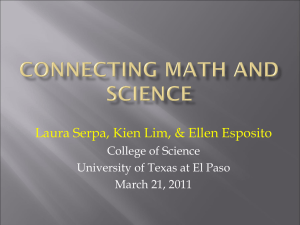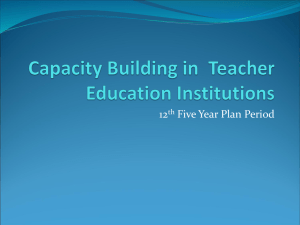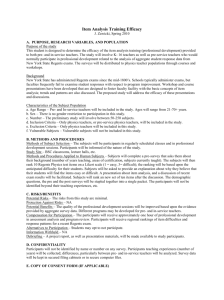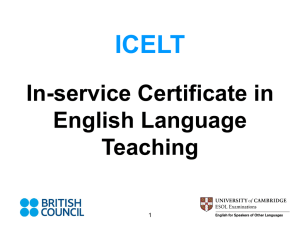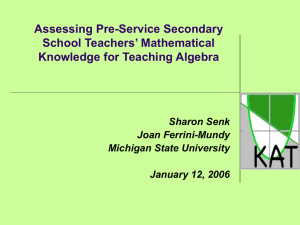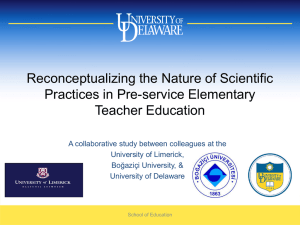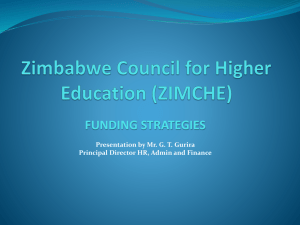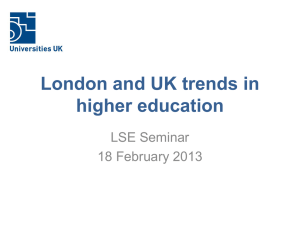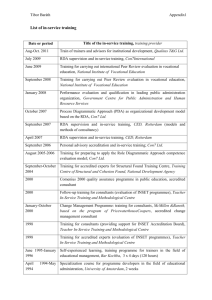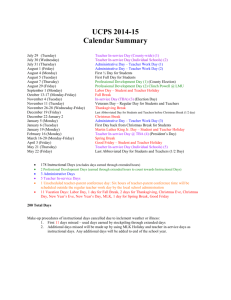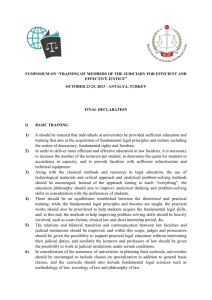PPT - Teacher Education
advertisement
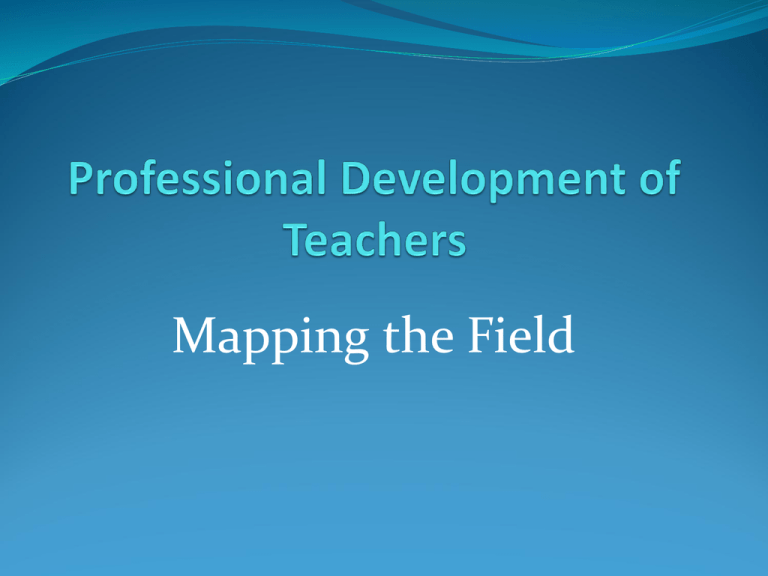
Mapping the Field Teacher Education Courses in India Grades 1-5: K12+ 2 Year Diploma in Elementary Teacher Education (ETE) Grades 6-10: Graduate+1 Year Bachelor in Education (B.Ed.) Grades 8-12: Post Graduate+1 Year Bachelor in Education 4 Year Integrated program in Regional Institutes of Education 4 Year Bachelor in Elementary Education (B.El.Ed) Recognition, Affiliation and Certification All teacher education programs require recognition by the National Council of teacher Education (NCTE) State Councils of Educational Research and Training (SCERT) provides affiliation and certification for Diploma programs State/Central universities provide affiliation and certification for Degree programs All India Teacher Education Institutions 2011 Stage Government Intake Private Intake Pre-primary 16 746 219 14102 Elementary 757 49089 4831 298278 B.Ed. 224 20031 5731 609496 B.Ed. Open U 24 13800 2700 16500 B.El.Ed - - 13 545 Policy issues: Pre-service Teacher Education Course duration 1-2 year top-up Monolithic program TEI culture static and structure Isolation of TEIs at both university and SCERT levels from Institutions of Higher Education (HEIs) Limited engagement with schools pedantic SCERTs have little or no links with HEIs University departments of education not organically linked with science, social science, humanities departments Some ways forward 2 years for B.Ed. with internship 3 years for ETE leading to degree 5 year integrated programs in education blended program wherein teachers continue to formal education through distance/vacation mode for 1-2 years after they join schools as teachers before they are deemed fully qualified at pre-service levels 4 year B.Sc. Ed /B.A. Ed. conducted by university departments in science, mathematics, social science, humanities departments In-Service Teacher Education Policy Issues: In-service teacher education National policy for provision of 3 week orientation for all teachers at the elementary level has been in place since 2000. The need now is to move from mechanistic approaches to organic ones rooting the process among the teachers creating planned spaces for their voice, knowledge and agency linked with higher education/research agencies on the one hand direct, intimate engagement with children’s learning, on the other. Enabling policy requirement for supporting networks Associations of teacher education Mathematics and Science Education For a Language Educator networks Social Science Education networks Inclusion and Equity For a Gender equality platforms Child Rights for a Child Studies units/centers Assessment networks Policies to link Teacher Education with Higher Education Teacher Education Cell in the University Grants Commission (UGC) State-level research institutions for curriculum studies, gender studies, cognitive studies, child development, linguistics Link SCERTs and District Institutions of Education and training with Research/Higher Education institutions Re-vitalizing District Institutes of Education and Training DIETs are connected to the schools in the district in the form of in-service teacher training for teachers. This space can be utilized to introduce the documentation, research. If the in-service training is imaginatively designed, DIETs will be able to engage school teachers so that they can incorporate ideas into their own classroom teaching engage in their own experimentations in the schools Ways to re-vitalize DIETs Document local knowledge resources such as local histories, geographies, biologies, anthropologies such as documenting flora, fauna, soil, water, terrain; folk lore, toys, games, puzzles, food types, measurements, indigenous practices etc. Researchers from HEIs can orient DIET Faculty, participate in design, collection of data, devise tools, orient DIET Faculty, school teachers and students to document and publishing their efforts The technical institutions and HEIs, through this engagement, will gain local knowledge, and may be able to suggest, increasingly refined field experiments in their area of specializations Supporting teachers to acquire qualifications An estimated 1 million teachers do not currently have the academic or professional qualifications mandated by the RtE. The current policy direction is to look for quick, one-shot distance education programs heavily rooted in ICT. A more sustained policy approach would be to generate local level coming together of groups of teachers with a credits based system to assess what they need to become qualified, and to set up a gradual 3-5 year program of study with commensurate rewards on attainment. Non-governmental agencies and organizations under Corporate Social Responsibility Policy support and synergies CSOs have overwhelming presence in pre-service teacher education. They need to engage in issues of quality through peer-influence and sharing platforms. CSO presence in in-service teacher education is rising exponentially in the states: overarching policies are required to move from fragmented sectoral approaches towards integrated synergistic approaches with proven outcomes. Learning from the global community Some international policies worth emulating Substitute teachers on call Teacher: Teacher Educator Ratio Mentoring system in schools Orientation for teacher educators Standards based system of education and teacher education Core values of equity, equality and inclusion Authentic vision and practice Thank you
